| spell | ui | event | logwage | married | female | age | nonwhite |
|---|---|---|---|---|---|---|---|
| 5 | 0 | 1 | 6.89568 | 1 | 0 | 41 | 0 |
| 13 | 1 | 1 | 5.28827 | 1 | 0 | 30 | 0 |
| 21 | 1 | 1 | 6.76734 | 0 | 0 | 36 | 0 |
| 3 | 1 | 1 | 5.97889 | 1 | 0 | 26 | 1 |
| 9 | 1 | 0 | 6.31536 | 0 | 0 | 22 | 0 |
| 11 | 1 | 0 | 6.85435 | 1 | 0 | 43 | 0 |
Explore survival functions for unemployment duration , we consider a cohort entering unemployment at the same time (first nonth) and we want to test if the survival rates are different for different age groups ,gender or unemployment insurance
Note
a closer look at survival analysis in unemployment
the dependent variable is made of two things
-
-
0implies a person has not found a job after9 periods(censored)
-
uistands forunemployment Insurance> the other variables are linked to that particular individual
Summary of the data at hand
Recoding the data
Explanatory Analysis
Staggered Entry situation
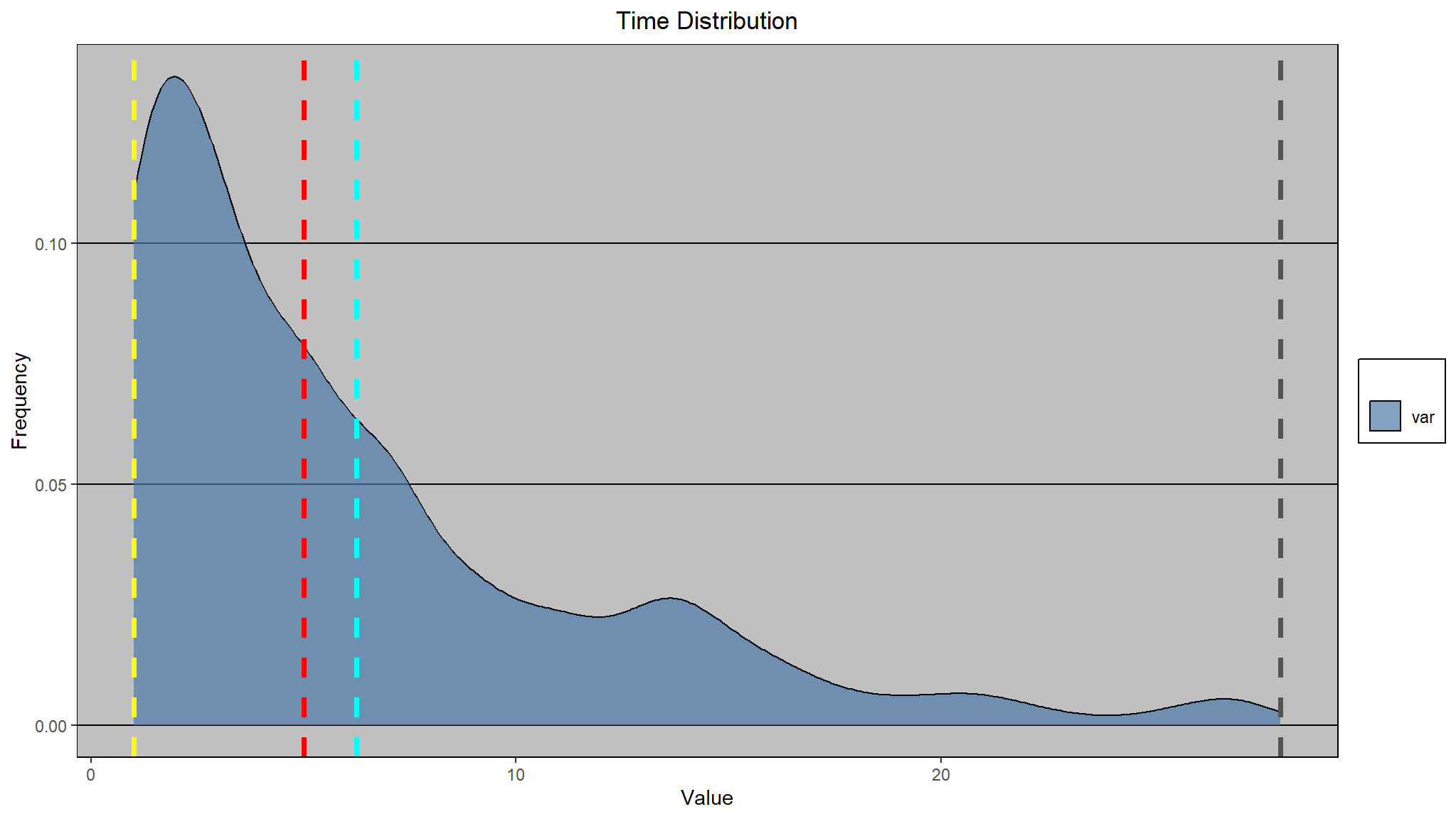

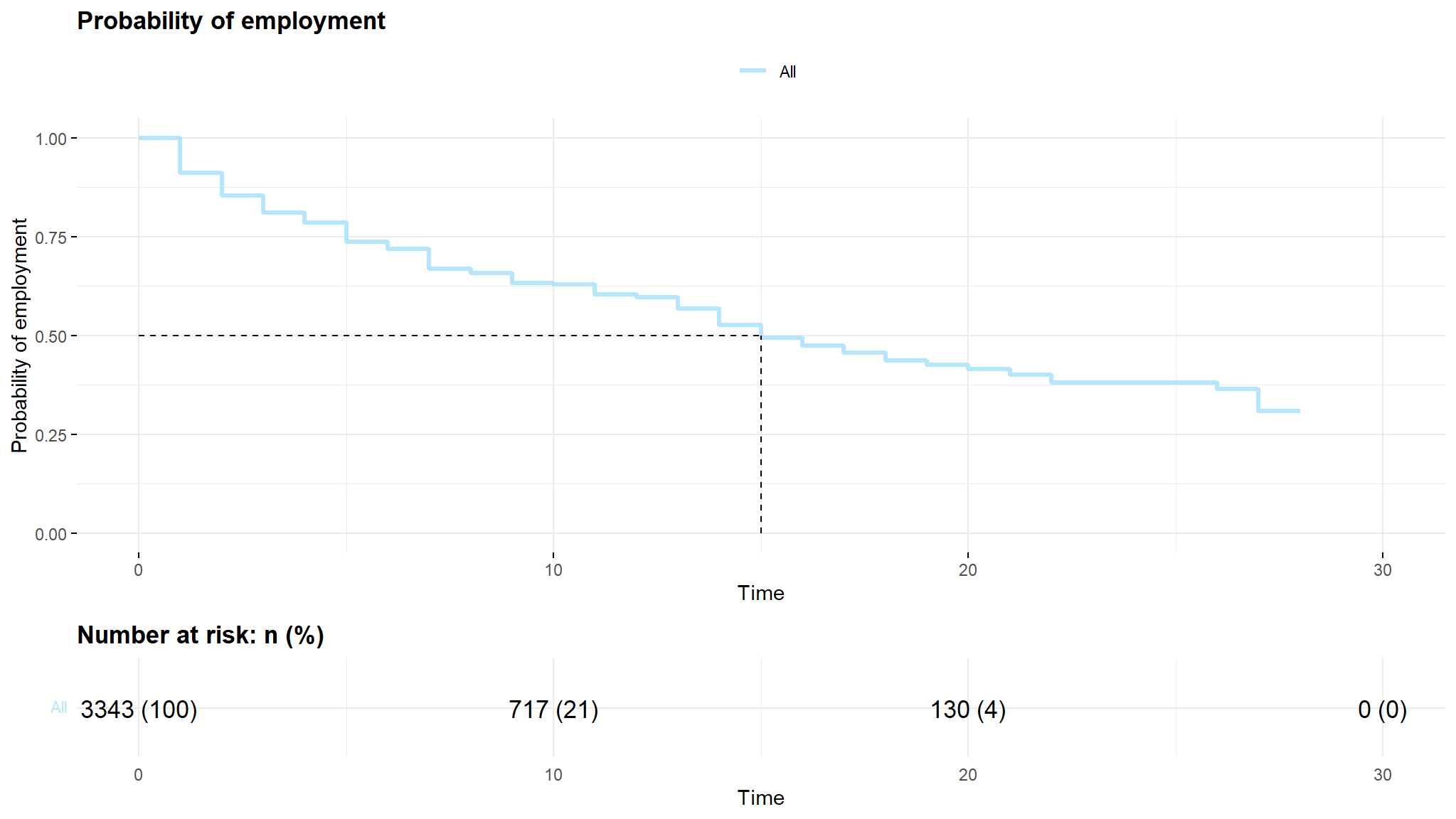
#> Call: survfit(formula = Surv(spell, event) ~ 1, data = out_new)
#>
#> time n.risk n.event survival std.err lower 95% CI upper 95% CI
#> 1 3343 294 0.912 0.00490 0.903 0.922
#> 2 2803 178 0.854 0.00622 0.842 0.866
#> 3 2321 119 0.810 0.00708 0.797 0.824
#> 4 1897 56 0.786 0.00756 0.772 0.801
#> 5 1676 104 0.738 0.00847 0.721 0.754
#> 6 1339 32 0.720 0.00882 0.703 0.737
#> 7 1196 85 0.669 0.00979 0.650 0.688
#> 8 933 15 0.658 0.01001 0.639 0.678
#> 9 848 33 0.632 0.01057 0.612 0.654
#> 10 717 3 0.630 0.01064 0.609 0.651
#> 11 659 26 0.605 0.01128 0.583 0.627
#> 12 556 7 0.597 0.01150 0.575 0.620
#> 13 509 25 0.568 0.01234 0.544 0.593
#> 14 415 30 0.527 0.01353 0.501 0.554
#> 15 311 19 0.495 0.01458 0.467 0.524
#> 16 252 10 0.475 0.01527 0.446 0.506
#> 17 201 8 0.456 0.01606 0.426 0.489
#> 18 169 7 0.437 0.01691 0.405 0.472
#> 19 149 4 0.426 0.01744 0.393 0.461
#> 20 130 3 0.416 0.01794 0.382 0.452
#> 21 109 4 0.400 0.01883 0.365 0.439
#> 22 82 4 0.381 0.02029 0.343 0.423
#> 26 48 2 0.365 0.02233 0.324 0.412
#> 27 33 5 0.310 0.02964 0.257 0.374
Note
- looking at the survival curve ,note that it always starts at 1 and goes down in time
- The median survival time is
14 periods - the output table shows that the probability of
survival(= finding a job)in the first 2 months is85.4% (84.2-84.66 CI), the probability of survival gradually decreases with time in the 28 months and almost approaching zero.
Summary by gender
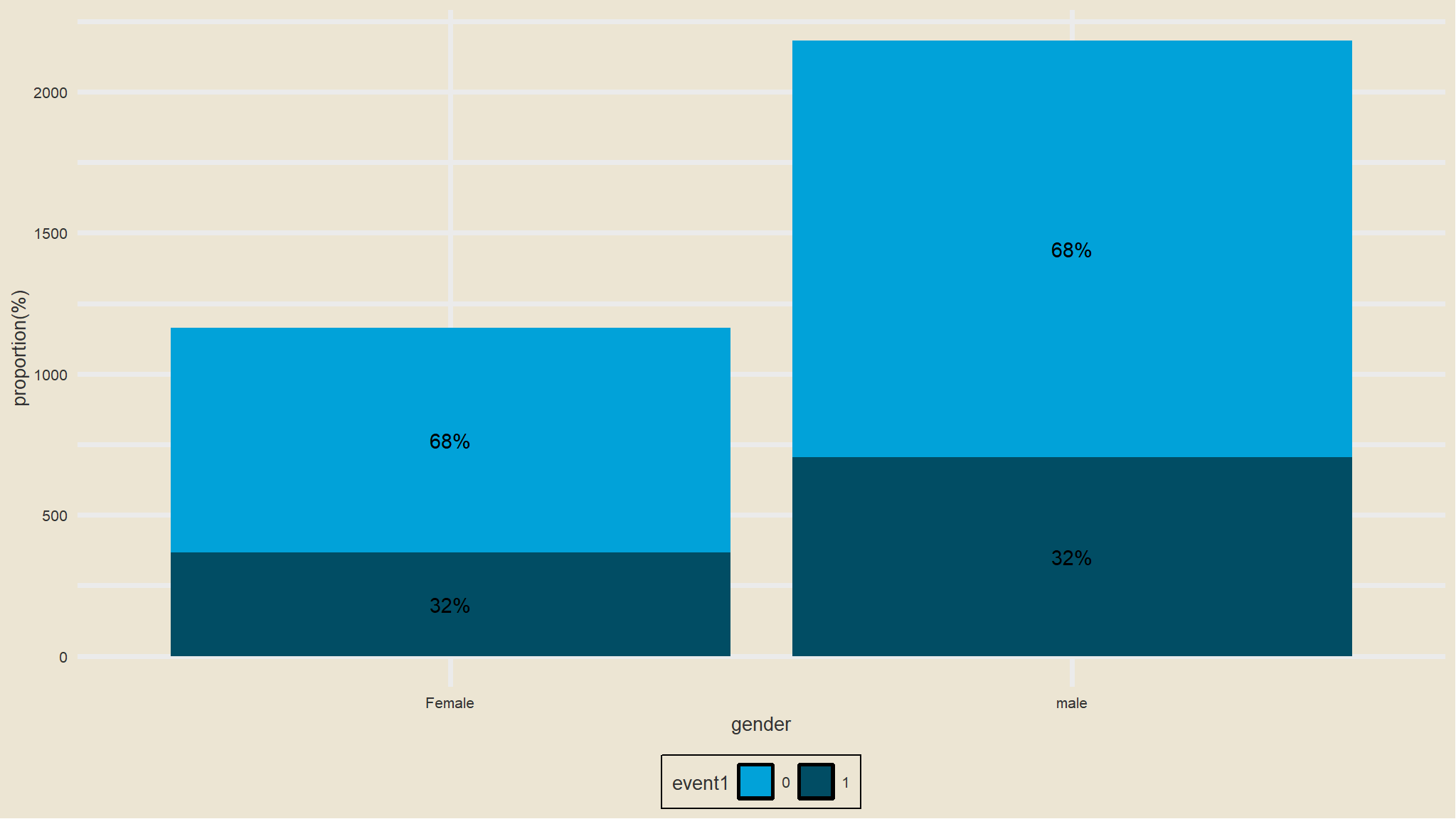
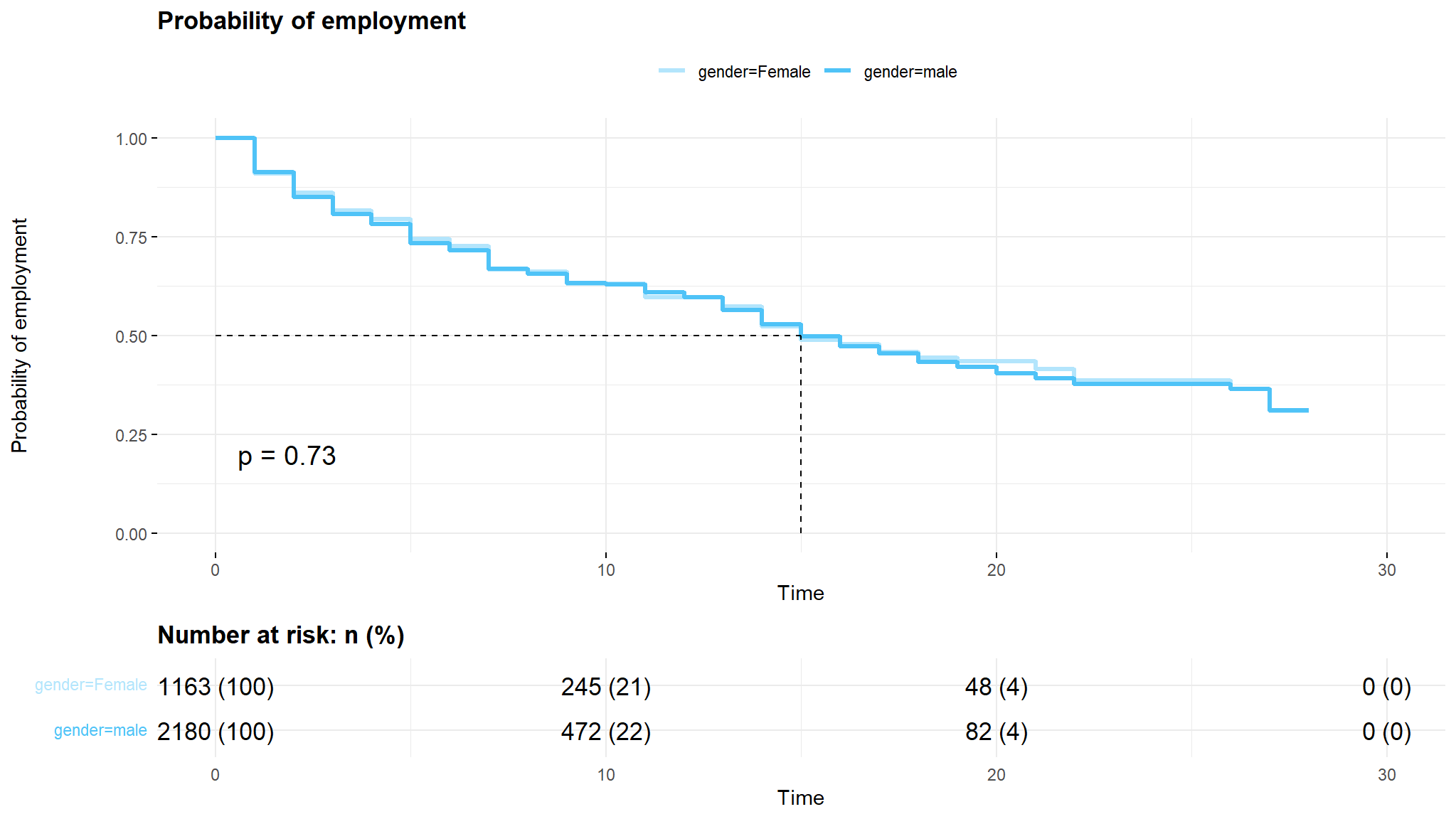
Note
- there are minor differences in the survival times (
time to get employed) between males and females
Summary by Unemployment Insurance
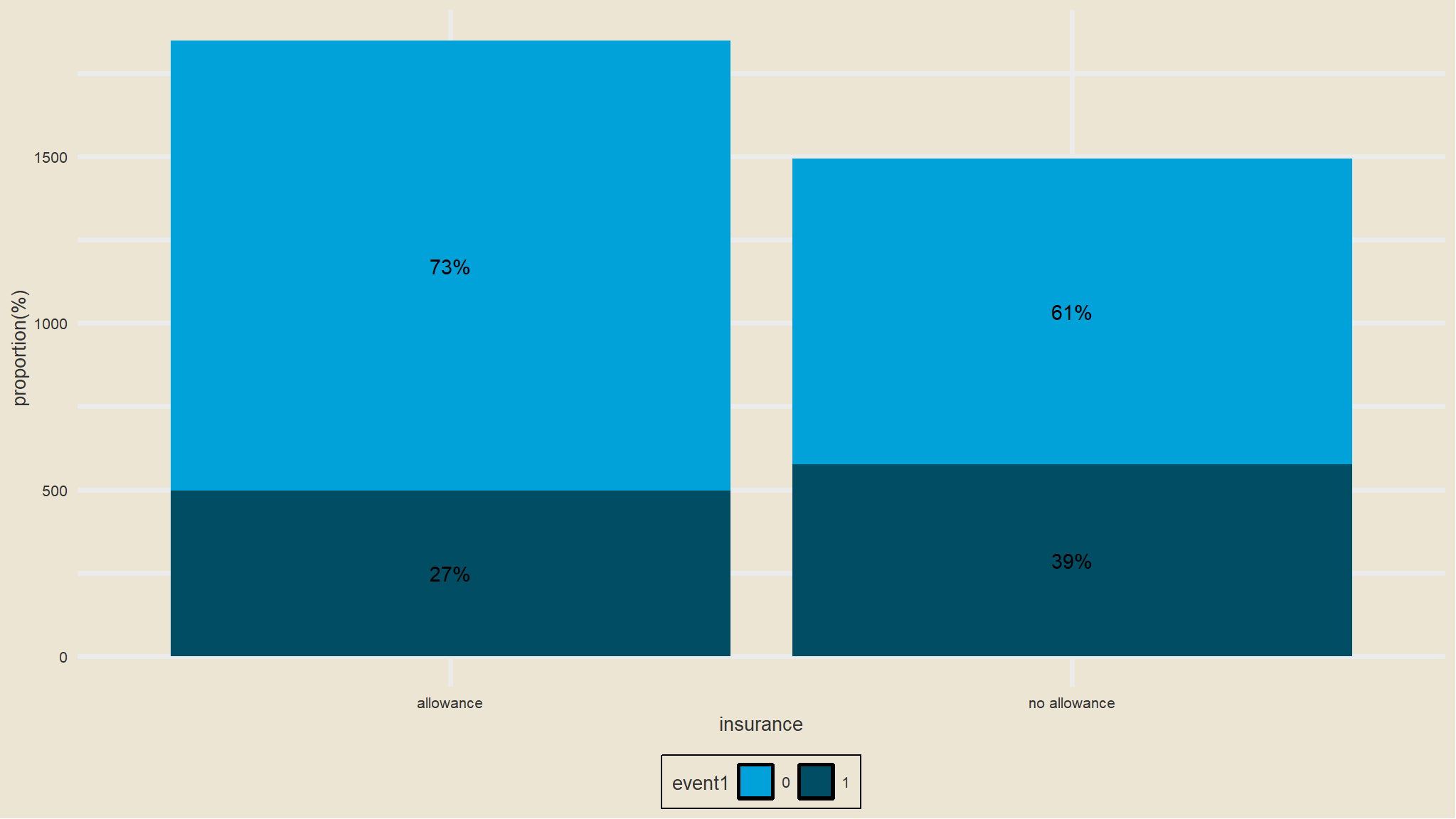
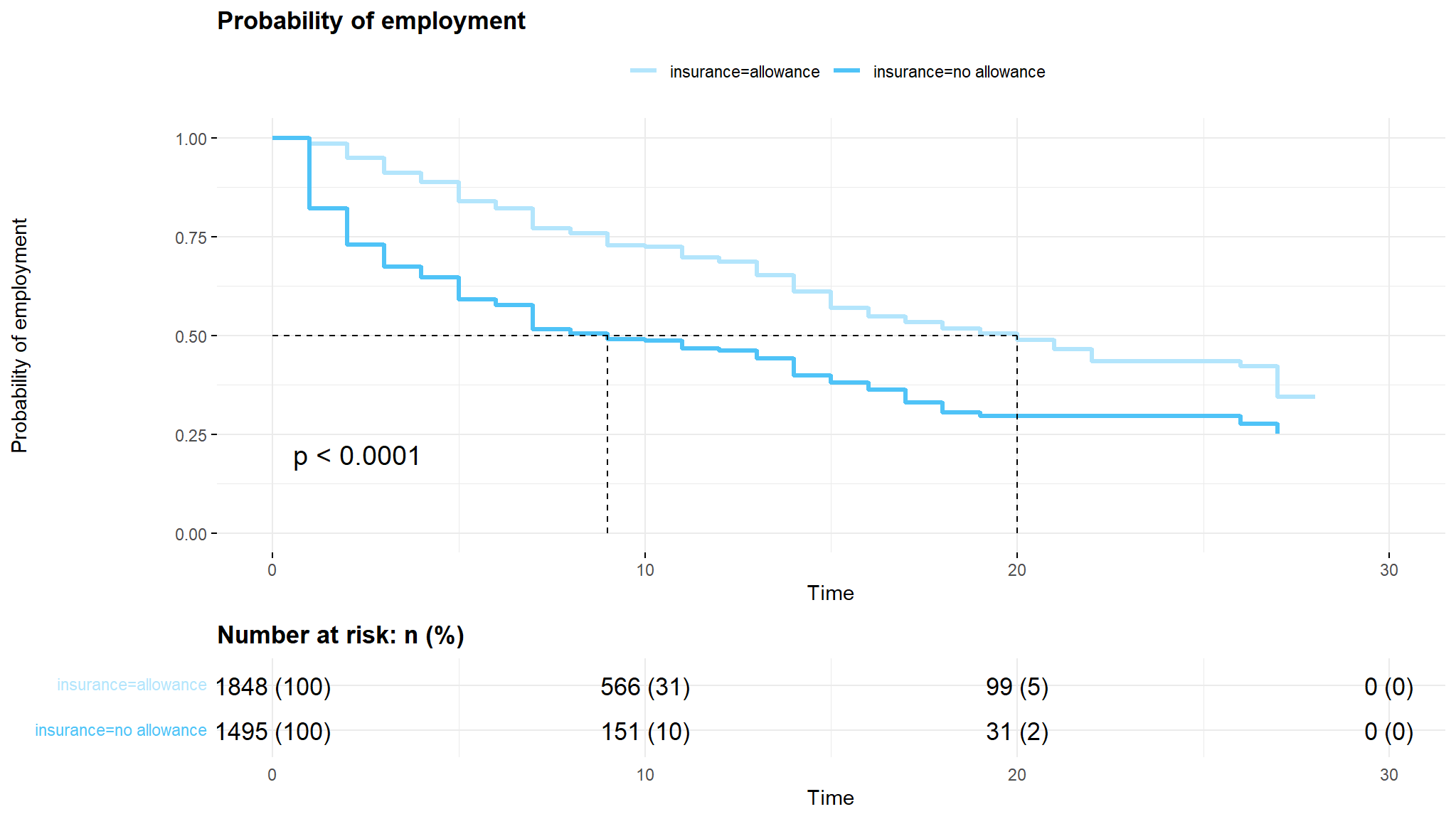
comment
- after half of the time intervals i.e (10 and 15) we see that those having unemployment benefit have about
75%survival while the other group has50%survival this means that75%of those taking allowance are still not employed after half of the time. - it can be noted from the log rank that the
survival timesbetween these groups is significantly different
Exploring Age
- distribution of age
#> Minimum: 20.00
#> Mean: 35.44
#> Median: 34.00
#> Mode: 27.00
#> Maximum: 61.00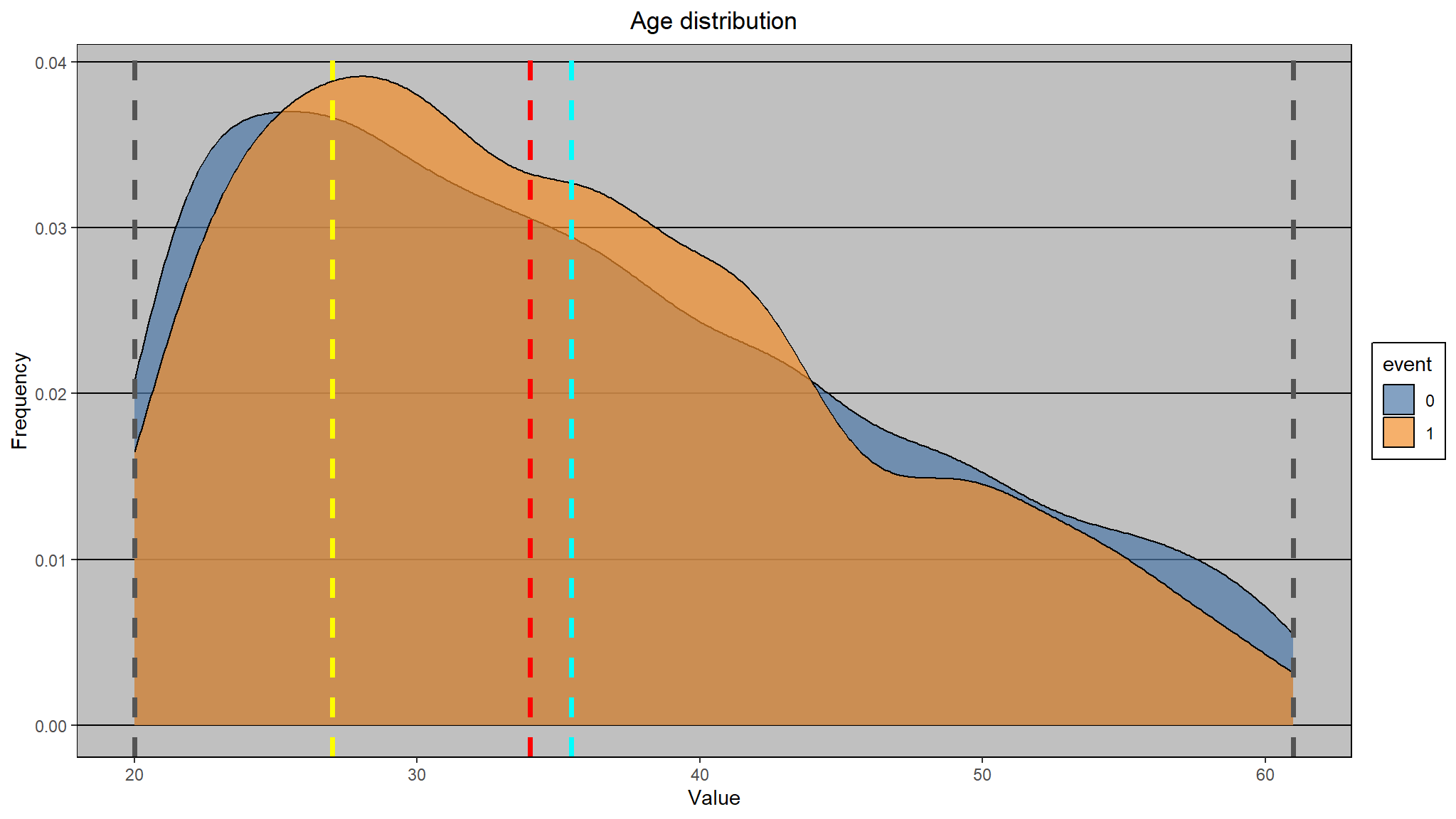
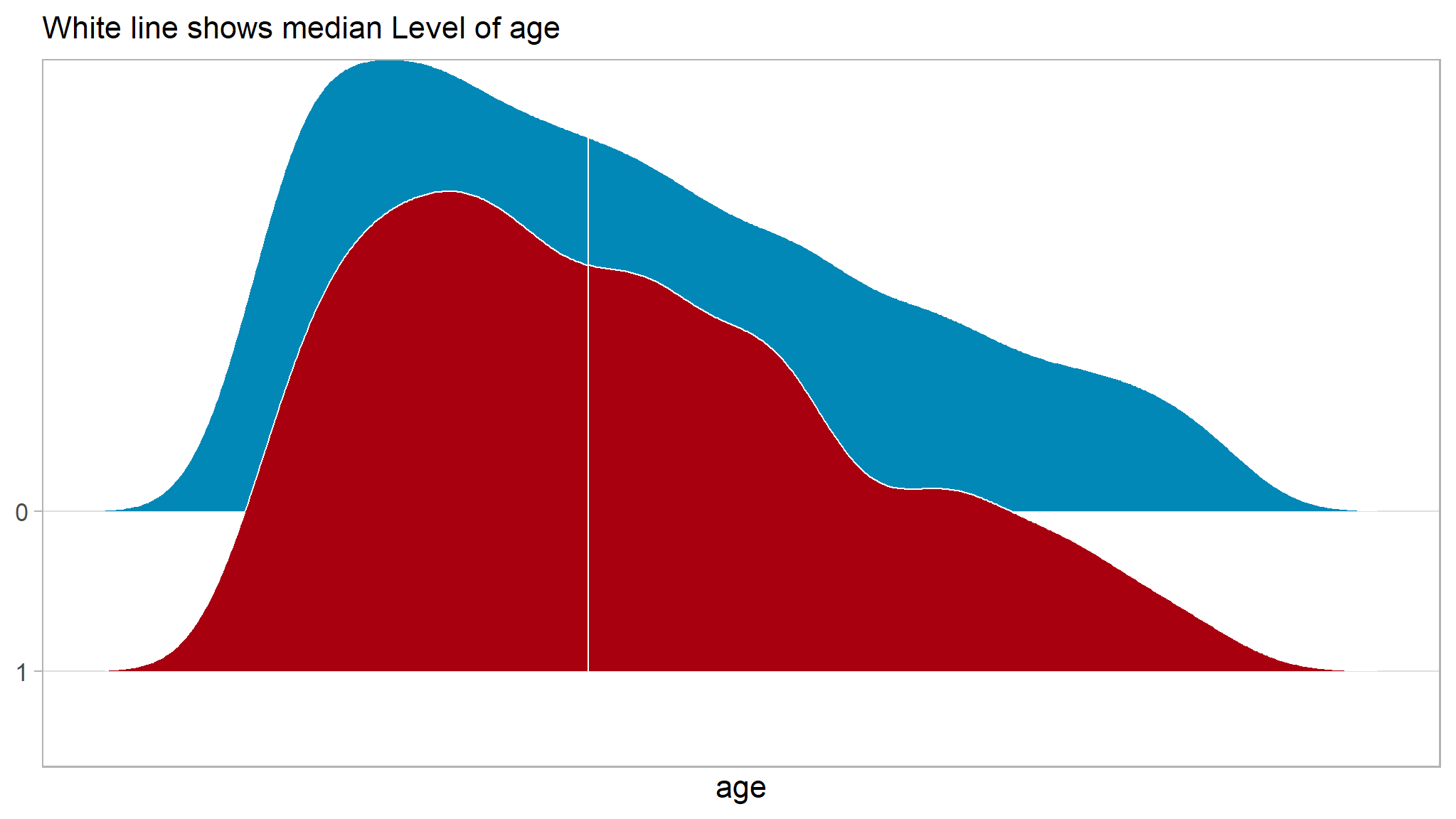
Put age into categories
- we attempt to determine weighted
(0%, 2.5%,10%,25%,50%,75%,90%,97.5%)quantiles of age and categorize the data in that order.
bins <- c(0,0.025,0.10,0.25,0.5,0.75,0.9,0.975,1)
split.Age <- wtd.quantile(out_new$age,probs=bins)
split.Age
#> 0% 2.5% 10% 25% 50% 75% 90% 97.5% 100%
#> 20 21 23 27 34 43 52 58 61
Note
the data above simply shows:
- minimum of
20 years of age - lower quartile of
27 yearsimplying that about25%are below the age of27 - median age of
34 yearsimplying that about50%are below the age of34 - upper quartile of
43 years - maximum of
61
- categorize age into the above bins
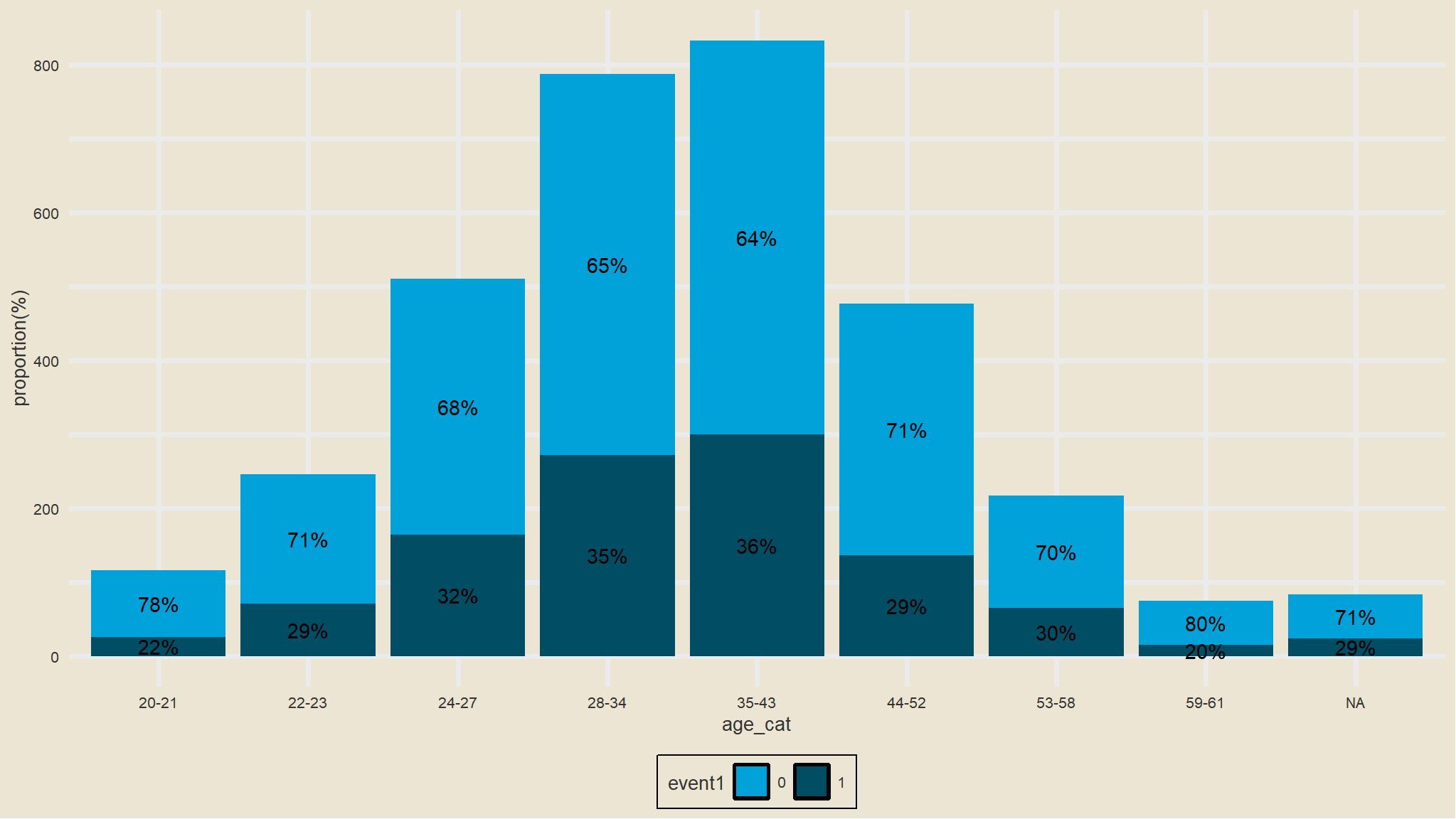

comment
- we notice a strong difference in these curves starting at
period 10and an almost inversion of them atperiod 20 - its easy and obvious to note that those in the upper
age groupsstay unemployment for a longer time implying that it is hard for the age groups44-52 and 53-61to get a job as compared to the lower age groups - those in the lower age groups get employed much faster (much easier for them to get employed)
try another binning
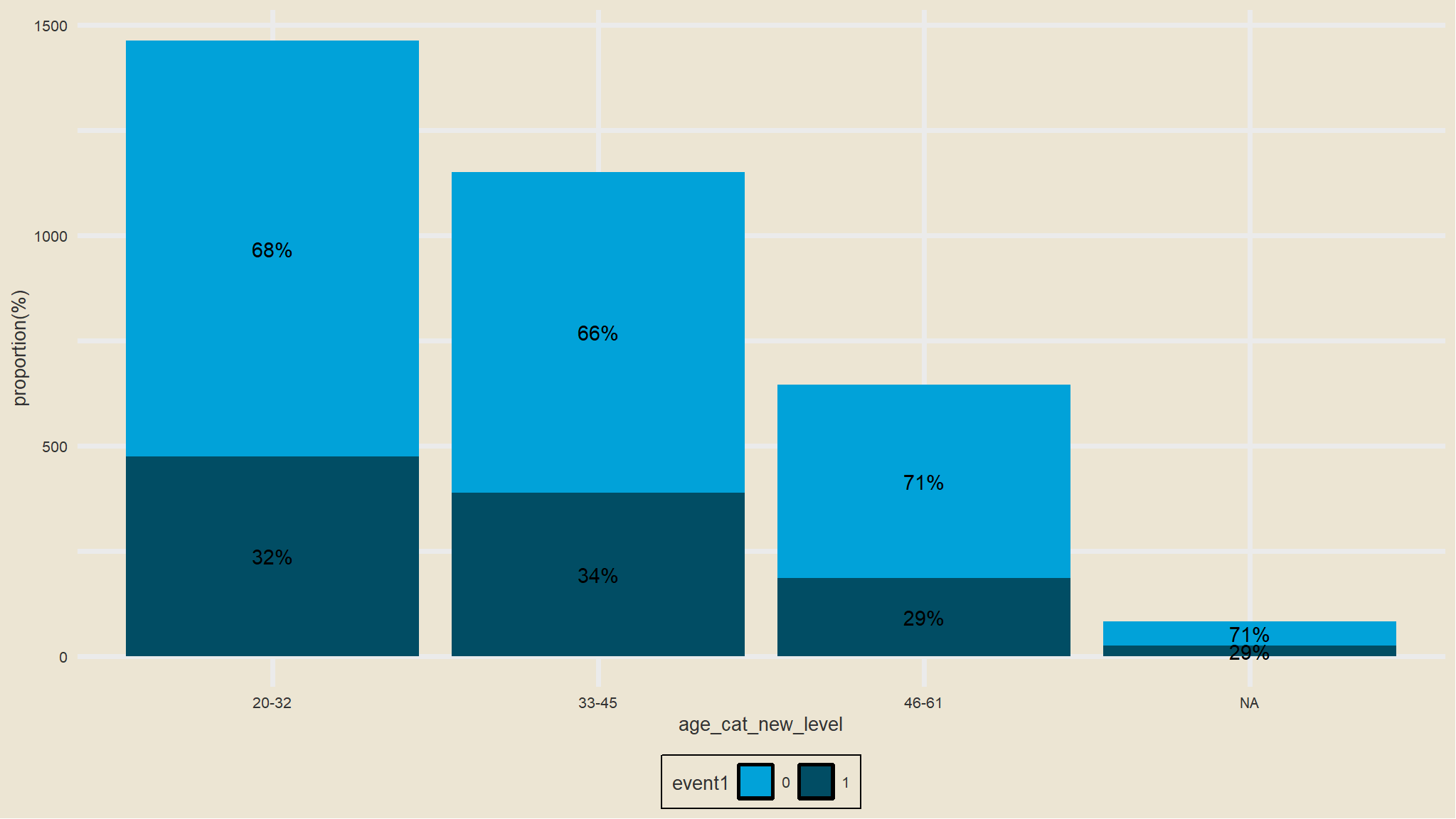

comment
- the observation is the same as from the previous age
bins
Exponential survival probability

Cox proportional Hazard
- assume
ageis not categorized
| Characteristic | HR1 | 95% CI1 | p-value |
|---|---|---|---|
| logwage | 1.69 | 1.50, 1.90 | <0.001 |
| gender | |||
| Female | — | — | |
| male | 0.86 | 0.75, 0.98 | 0.028 |
| age | 0.99 | 0.98, 1.0 | <0.001 |
| insurance | |||
| allowance | — | — | |
| no allowance | 2.79 | 2.46, 3.16 | <0.001 |
| 1 HR = Hazard Ratio, CI = Confidence Interval | |||
Comments
- holding all other covariates constant ,increase in age reduces the
hazard of employment by 0.98 - an increase in log wage increases the hazard of employment by
0.48 -
manhave a decreasedhazard of employementas compared towomen
- what if age is categorised
| Characteristic | HR1 | 95% CI1 | p-value |
|---|---|---|---|
| logwage | 1.66 | 1.47, 1.86 | <0.001 |
| gender | |||
| Female | — | — | |
| male | 0.86 | 0.76, 0.99 | 0.034 |
| age_cat_new_level | |||
| 20-32 | — | — | |
| 33-45 | 0.93 | 0.81, 1.06 | 0.3 |
| 46-61 | 0.70 | 0.58, 0.83 | <0.001 |
| insurance | |||
| allowance | — | — | |
| no allowance | 2.82 | 2.49, 3.20 | <0.001 |
| 1 HR = Hazard Ratio, CI = Confidence Interval | |||
Note
- the results are almost the same , noting that the age groups
33-45and46-61have decreasedhazards of employmentas compared to the20-32age group.
which model is better
AIC(cox_m,cox_m1)
#> df AIC
#> cox_m 5 15197.10
#> cox_m1 4 15593.82
Note
- a model with
age categorizedperform better with a lowerAkaike Information Criterionof15451.18
Visualise the results

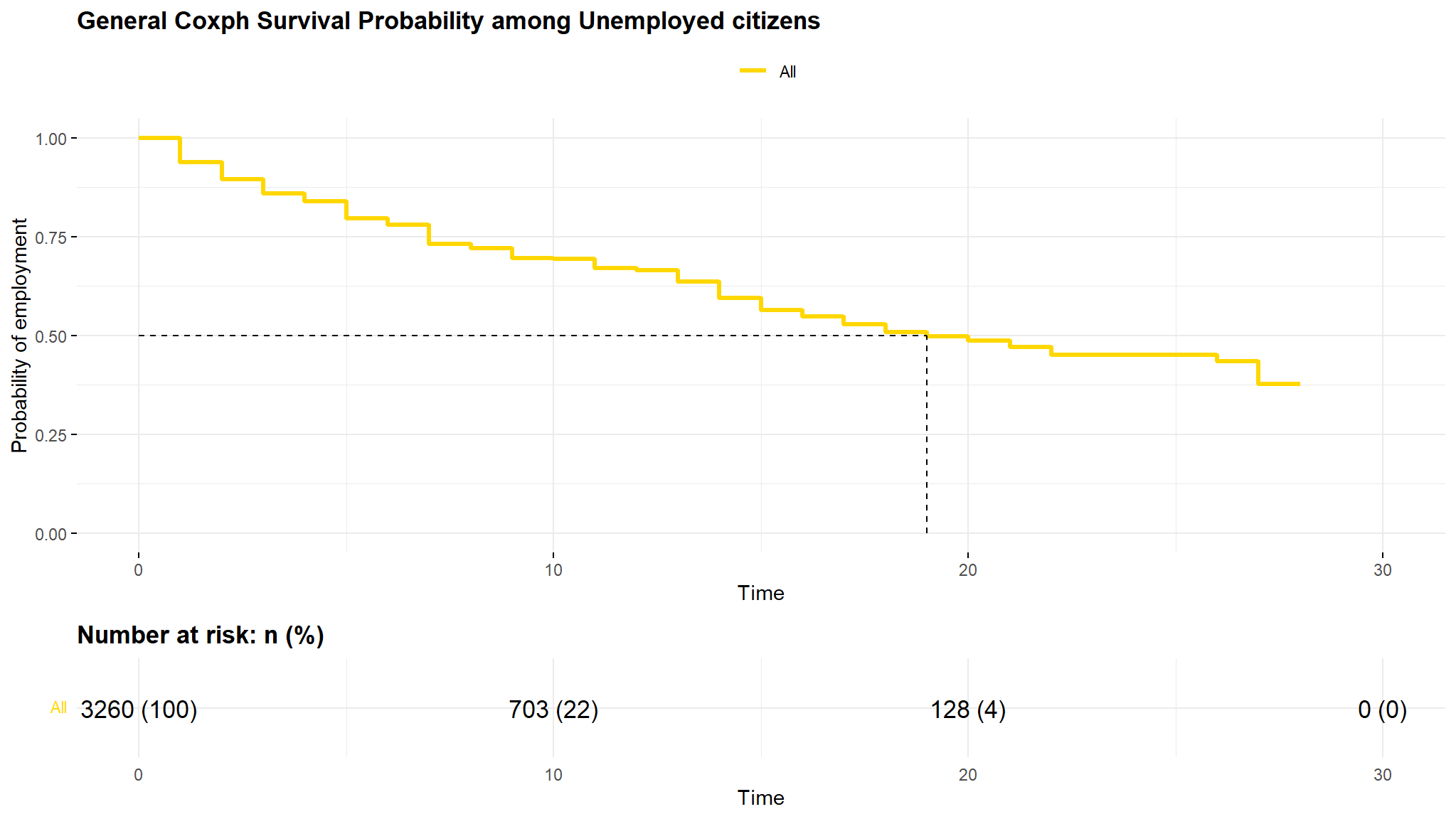
Conclusions
- there is no strong differences between women and men concerning their unemployment duration
- the
higher age groupshave a higher probability of remaining unemployed , i think it is harder for them to adapt to the new labor market - lastly as seen from the kaplan Meier Curve , those without
insuranceallowance have an increased hazard of employment as compared to the other group.